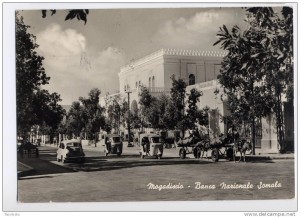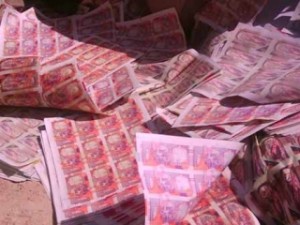By Mohamed Dalmar
In January 2010, the then Transitional National Government ordered the printing of Somali shilling banknotes worth 5 trillion from Sudan at the cost of US$ 17 million. However, the delivery of this money was halted after meeting a strong opposition from the International community, Puntland and concerned Somali citizen on the grounds believed that the Government has not done the preparatory work needed to introduce a new currency and that, absent any effective monetary policy, the currency will only add to the monetary chaos already afflicting the country. A new Somali Federal Government came to power in September 2012. It also had to refrain from importing the banknotes from Sudan although under pressure to print money. As of to date the banknotes lie idle in the safes of the Sudanese printing company and their delivery has been postponed to an unknown future.
 This paper discusses the challenges that the government faces in introducing a new currency, the preparatory work it has to undertake before putting such currency in circulation and the mechanism through which it can create a strong and credible national currency.
This paper discusses the challenges that the government faces in introducing a new currency, the preparatory work it has to undertake before putting such currency in circulation and the mechanism through which it can create a strong and credible national currency.
Historical context
In the 1980s, before the collapse of the Somali state, Somalia has had a very distressing monetary experience marked by financial chaos, currency collapse, runaway inflation and bank failure. By 1989, the whole banking system either collapsed or was on the verge of collapsing owing to too much government involvement, mismanagement and corruption. The Central bank lost control of money supply and became mainly a tool for financing the government’s huge budget deficit; the Commercial and Savings Bank was declared bankrupt; and the Somali Development Bank was incapacitated because of lack of resources.
That the situation got out of control is demonstrated by the following facts:
- Just in one year, 1989, the last year for which we have data, money supply increased by a staggering amount of So.Sh. 96 billion;
- The Commercial and Savings Bank made unsecured and fraudulent loans to the tune of 60 billion;
- Inflation rate skyrocketed by 110% and the shilling depreciated by 278%
All this money was created while per capita GNP declined in real terms by 29% between 1978 and 1989[. Such was the legacy of the government before it collapsed: a worthless currency and a banking system in tatters.
While the official banking system was failing and losing public confidence, an informal parallel (black) market banking system was emerging and growing in strength. To fill the gap left by the official banking system, a multitude of small parallel banks started providing banking services, including cashing cheques at heavy discount, converting currency, safe keeping of money and providing small scale lending facilities. Most of these small informal banks were located in Bakaraha market, the Wall Street of Somalia.
 Following the collapse of the Somali state and the outbreak of the civil war in 1991, the Central Bank and what was left of the other state-owned banks vanished. Their cash and valuables were looted, their buildings were vandalized and their records were destroyed. However, the disappearance of the formal government banks did not mean the end of the financial services in Somalia. The foreign exchange market operated by money-changers grew bigger and more vibrant as it benefited from the absence of government controls and the sizeable inflow of remittances from the Somali diaspora. These remittances are channeled through the money transfer companies, the Hawala which built, over the years, a very elaborate network of offices and agents capable of transferring funds not only to Somalia but also to any part of the world instantly. In addition, the Hawala evolved into providing some basic banking services such as accepting non-interest-bearing deposits and the issuance of vouchers.
Following the collapse of the Somali state and the outbreak of the civil war in 1991, the Central Bank and what was left of the other state-owned banks vanished. Their cash and valuables were looted, their buildings were vandalized and their records were destroyed. However, the disappearance of the formal government banks did not mean the end of the financial services in Somalia. The foreign exchange market operated by money-changers grew bigger and more vibrant as it benefited from the absence of government controls and the sizeable inflow of remittances from the Somali diaspora. These remittances are channeled through the money transfer companies, the Hawala which built, over the years, a very elaborate network of offices and agents capable of transferring funds not only to Somalia but also to any part of the world instantly. In addition, the Hawala evolved into providing some basic banking services such as accepting non-interest-bearing deposits and the issuance of vouchers.
A striking development since 1992 has been the printing of fake currency by warlords, business people, faction leaders and regional administrations to fund their political or perhaps illegal purposes. The importation of fake currency caused runaway inflation that affected ordinary people’s lives by eroding the value of their meagre incomes. The situation became worse when in 2007 some unscrupulous business people and regional administrators imported printing machines and produced notes of low quality further eroding the value of the Somali shilling and its usefulness as a currency. In the last three years, however, the Somali shilling showed remarkable strength simply because no new fake currency was issued. Currently, the exchange rate is stable at around So.Sh. 20,000 per US dollar. To my knowledge, no accurate statistics are available as to how much fake money was created. I would not exaggerae if I estimate that close to a trillion worth of Somali shilling banknotes have been put in circulation since 1992.
Read more: Somalia Long road to currency reform
Mohamed Dalmar
Email:[email protected]
——————
Mr. Dalmar has written a book and numerous articles/analysis on Somalia’s financial environments post the collapse of Somalia central government., Mr.Dalmar is also the former Director General of Somalia’s Central Bank and prof of Economics at the faculty of Economic, Somali National University. Mr. Dalmar is a contributor of WardheerNews on financial affairs.
We welcome the submission of all articles for possible publication on WardheerNews.com. WardheerNews will only consider articles sent exclusively. Please email your article today . Opinions expressed in this article are those of the author and do not necessarily reflect the views of WardheerNews.
WardheerNew’s tolerance platform is engaging with diversity of opinion, political ideology and self-expression. Tolerance is a necessary ingredient for creativity and civility.Tolerance fuels tenacity and audacity.
WardheerNews waxay tixgelin gaara siinaysaa maqaaladaha sida gaarka ah loogu soo diro ee aan lagu daabicin goobo kale. Maqaalkani wuxuu ka turjumayaa aragtida Qoraaga loomana fasiran karo tan WardheerNews.
Copyright © 2024 WardheerNews, All rights reserved


